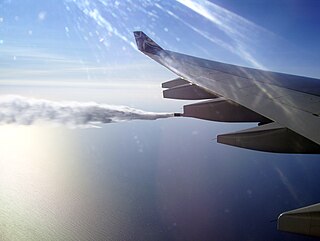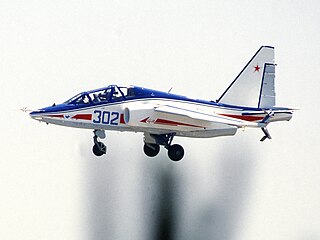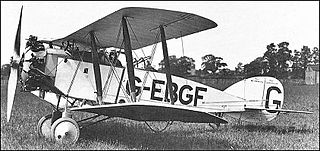Related Research Articles
Payload is the object or the entity which is being carried by an aircraft or launch vehicle. Sometimes payload also refers to the carrying capacity of an aircraft or launch vehicle, usually measured in terms of weight. Depending on the nature of the flight or mission, the payload of a vehicle may include cargo, passengers, flight crew, munitions, scientific instruments or experiments, or other equipment. Extra fuel, when optionally carried, is also considered part of the payload.

A multistage rocket or step rocket is a launch vehicle that uses two or more rocket stages, each of which contains its own engines and propellant. A tandem or serial stage is mounted on top of another stage; a parallel stage is attached alongside another stage. The result is effectively two or more rockets stacked on top of or attached next to each other. Two-stage rockets are quite common, but rockets with as many as five separate stages have been successfully launched.
Thrust-to-weight ratio is a dimensionless ratio of thrust to weight of a rocket, jet engine, propeller engine, or a vehicle propelled by such an engine that is an indicator of the performance of the engine or vehicle.

The Zodiac Milpro Futura Commando 470 or in short FC470 combat rubber raiding craft (CRRC), also known as the "combat rubber reconnaissance craft," is a specially fabricated rubber inflatable boat often used by the U.S. Navy, U.S. Marine Corps, the U.S. Army, and others. The CRRC is typically called "Zodiac," referring to the boat's manufacturer, Zodiac Milpro.

Titan IIIB was the collective name for a number of derivatives of the Titan II ICBM and Titan III launch vehicle, modified by the addition of an Agena upper stage. It consisted of four separate rockets. The Titan 23B was a basic Titan II with an Agena upper stage, and the Titan 24B was the same concept, but using the slightly enlarged Titan IIIM rocket as the base. The Titan 33B was a Titan 23B with the Agena enclosed in an enlarged fairing, in order to allow larger payloads to be launched. The final member of the Titan IIIB family was the Titan 34B which was a Titan 24B with the larger fairing used on the Titan 33B.

The Piper PA-24 Comanche is an American single-engine, low-wing, all-metal monoplane of semimonocoque construction with tricycle retractable landing gear and four or six seats. The Comanche was designed and built by Piper Aircraft and first flew on May 24, 1956. Together with the PA-30 and PA-39 Twin Comanches, it made up the core of Piper's lineup until 1972, when the production lines for both aircraft were destroyed in the 1972 Lock Haven flood.

The maximum takeoff weight (MTOW) or maximum gross takeoff weight (MGTOW) or maximum takeoff mass (MTOM) of an aircraft is the maximum weight at which the pilot is allowed to attempt to take off, due to structural or other limits. The analogous term for rockets is gross lift-off mass, or GLOW. MTOW is usually specified in units of kilograms or pounds.

A loadmaster is an aircrew member on military transport aircraft or civilian aircraft tasked with the safe loading, transport and unloading of aerial cargoes. Loadmasters serve in the militaries and civilian airlines of many nations.

Flight planning is the process of producing a flight plan to describe a proposed aircraft flight. It involves two safety-critical aspects: fuel calculation, to ensure that the aircraft can safely reach the destination, and compliance with air traffic control requirements, to minimise the risk of midair collision. In addition, flight planners normally wish to minimise flight cost through the appropriate choice of route, height, and speed, and by loading the minimum necessary fuel on board. Air Traffic Services (ATS) use the completed flight plan for separation of aircraft in air traffic management services, including tracking and finding lost aircraft, during search and rescue (SAR) missions.

The Stroukoff YC-134, designed in 1956, was based heavily on the Fairchild C-123 Provider, itself designed by Michael Stroukoff. The United States military contracted with Stroukoff Aircraft Corporation to develop an improved version of the aircraft, combining features that the company had developed for the YC-123D and YC-123E.

Fuel dumping is a procedure used by aircraft in certain emergency situations before a return to the airport shortly after takeoff, or before landing short of the intended destination to reduce the aircraft's weight.
Empty weight (EW) is the sum of the ‘as built’ manufacturer's empty weight (MEW), plus any standard items (SI) plus any operator items (OI), EW = MEW + SI + OI. The EW is calculated for each aircraft series and each unique configuration of an aircraft and is confirmed by periodically weighing it. The "Operating empty weight" (OEW) is the sum of the empty weight and the crew plus their baggage.

The Sukhoi Su-28 is a downgraded trainer variant of the Su-25UB / Su-25T, with reductions in avionics and aircraft systems, together with the elimination of all weapon-carrying capability. It was developed as a replacement for the Aero L-39 Albatros. The Su-28 trainer is intended for technical skill, general flight and formation flying training. It is also used as an aerobatic aircraft.
The zero-fuel weight (ZFW) of an aircraft is the total weight of the airplane and all its contents, minus the total weight of the usable fuel on board. Unusable fuel is included in ZFW. Remember the takeoff weight components contributions:

The Bristol Type 76 Jupiter Fighter and Type 89 Trainer were derivatives of the British fighter of the First World War, powered by Bristol Jupiter radial engines. While unsuccessful as a fighter, it was used as an advanced trainer aircraft between 1924 and 1933.
In aviation, manufacturer's empty weight (MEW) is the weight of the aircraft "as built" and includes the weight of the structure, power plant, furnishings, installations, systems, and other equipment that are considered an integral part of an aircraft before additional operator items are added for operation.
The aircraft gross weight is the total aircraft weight at any moment during the flight or ground operation.

An aircraft flight manual (AFM) is a paper book or electronic information set containing information required to operate an aircraft of certain type or particular aircraft of that type. The information within an AFM is also referred to as Technical Airworthiness Data (TAWD). A typical flight manual will contain the following: operating limitations, Normal/Abnormal/Emergency operating procedures, performance data and loading information.

The ScaleWings SW51 Mustang, formerly marketed as the FK-Lightplanes FK51 Mustang, is an Austrian ultralight, light-sport aircraft and homebuilt aircraft that was designed by ScaleWings of Strasswalchen, Austria and was initially produced by FK-Lightplanes of Krosno, Poland, who introduced it publicly at the AERO Friedrichshafen show in 2013. After FK-Lightplanes ceased production, the design was built by ScaleWings.
The empty weight of a vehicle is based on its weight without any payload.
References
- ↑ "Definitions". Virginia Register of Regulations. Retrieved 4 September 2024.